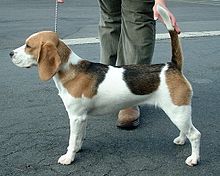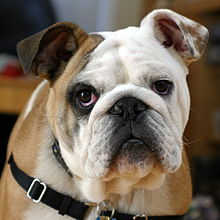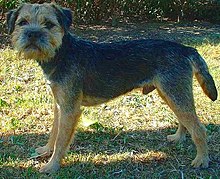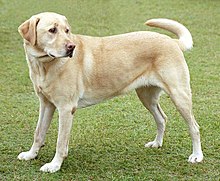- beagles like a lot of attention and readily respond well to a lot of affection and kindness.
- They look to please and are generally very quick learners. They also like to be active, and often look at training as a game.
- Very young puppies have short attention spans and it may take several weeks before they fully grasp what it is you are trying to teach them.
- Although a puppy's kidneys take several months to develop fully, you should begin housebreaking them by the time they are 2 months old
- it is important to keep to a regular feeding schedule. You'll find that the puppy will learn to anticipate these times.
- young dogs up to six months old should be taken out at least five times a day, while those six to nine months should go outside at least four times daily.
- While puppies may fight walking on a leash by tugging against you or even refusing to move (either in play or because they are frightened), just keep walking and pulling him along, and speak to him reassuringly.
- you must take it for extended walks and remember to take it for a swim or a hike.
- Beagle doesn't get any activity to make use of its energy, then it becomes restless and causes a lot of unwanted indoor destruction. It tends to keep on chewing or digging things.
- property without a fence, install some fences so that the Beagle doesn't get lost.
- A Beagle is a pack animal - it always prefers to be with a group. Never try to keep a Beagle alone for long periods of time. This will make them bad tempered and lazy.
Showing posts with label Famous Dogs. Show all posts
Showing posts with label Famous Dogs. Show all posts
Beagle Useful Training Tips
Labels:
Famous Dogs,
Training
Beagle Name And History
 |
Country of origin Great Britain
Traits
Coat Close, hard, hound coat of medium length
Color Tricolour or white in combination with red, lemon, or orange
Litter size 2–14 puppies
Life span 12–15 years
Beagle History And Origin
- The origin of the word "beagle" is uncertain, although it has been suggested that the word derives from the French or from an Old English, French, or the Gaelicword beag, meaning "little."
- beagle-type dogs have existed for over 2,000 years, the modern breed was developed in Great Britain around the 1830s from several breeds, including the Talbot Hound, the North Country Beagle, the Southern Hound, and possibly the Harrier.
- Beagles have been depicted in popular culture since Elizabethan times in literature and paintings, and more recently in film, television and comic books.Snoopy of the comic strip Peanuts has been promoted as "the world's most famous beagle"
Labels:
Famous Dogs,
Nick Names,
Origin
Vital Tips For Daschund Groming
Brushing
- A regular brushing with a soft bristle brush will be sufficient.
- Wirehaired dachshunds need more frequent brushing with a short napped wire bristle brush, especially after the annual spring and fall molting.

- Longhaired dachshunds needs to be regularly brushed and then combed.
Simple tips for combing and brushing your dog's coat
- A grooming table has a loop you can put around your dog's neck to better control while you work on the coat.
- Next, section off your dog's coat with hair clips or barrettes so that you can concentrate on one area at a time. Brush through each section, then follow with a comb.
- For shorthaired dachshunds, use a hard rubber brush or a mitt with rubber nubs. After brushing use a silk scarf and rub it over the coat to shine it up as finishing touch.
Shedding
You can also give your dog fatty acids such as fish oil or other liquids or capsules specially formulated for improved hair coat and skin quality. This won't stop shedding.
Bathing

- Dachshunds produce a special hair fat that serves an insulating layer to protect it against the elements.
- Bathing removes this hair fat which makes the coat softer but also makes your dog more vulnerable.
Longhaired grooming

- it is important to blow-dry them after you bathe them instead of allowing them to air-dry.
- Keeping the coat brushed and cleaned regularly goes a long way in keeping her longhaired coat manageable.
- In some instances if you've neglected grooming your longhaired, she may have some serious tangle issues that may need to be cut out.
Additional brushing tips
- Brush in the direction of hair growth, beginning at the head, and work towards the tail and down the legs.
- Slicker brushes are ideal for this purpose but are also a good general brush if used lightly
- Pin brushes, with rounded tips to prevent damage to the skin, are good for dogs with long, fine hair.
- Bristle brushes are good for dogs with very long coats and help add shine to the short coat
- Grooming mitts are also good for shorthaired to add polish and shine once the loose hairs are removed.

Nail trimming
 Exercising your dachshund on pavement regularly helps knock back claws nicely. Otherwise you will need to trim the claws. Use a trimmer designed for dog’s claws.
Exercising your dachshund on pavement regularly helps knock back claws nicely. Otherwise you will need to trim the claws. Use a trimmer designed for dog’s claws.
Labels:
Famous Dogs,
Grooming
Dachshund Training process,Best way to train Dachshund puppy
They have to learn to obey the basic commands in the training process.
- Basic commands like sit, stay and off must be taught to your Dachshund puppies.While he performs the action in the right manner, you can immediately offer the treat to him.
- Dachshund puppy has long backs and short legs and hence all the dog tricks may not be possible for him.
- There are some tricks that involve speaking, shaking, or rolling over and your dachshund puppy, if trained properly, will be able to them.
- Tricks like fetching and agility training may be a little tough and hence you should limit them to a lower level so that you can prevent back injuries to puppy.
- Dachshund puppy is a stubborn animal and hence you must be more stubborn to train him.
- For potty training him, you must take him to the chosen place many times during the day for relieving himself.
- He will slowly start associating the spot with the business of potty and does the act rightly whenever you take him over there.
- You should be consistent in dachshund puppy training.
- Give dachshund puppy plenty of physical exercises appropriate to his age. Long walks and play will make him tired and he will not indulge in undesirable behavior like chewing your expensive furniture, carpets or shoes.
 |
Labels:
Famous Dogs,
Training
dachshund History And Origin

- The dachshund is a short-legged, long-bodied dog breed belonging to the hound family.
- The standard size dachshund was bred to scent, chase, and flush out badgers.
- Dachshund was developed to hunt smaller prey such as rabbits.
- In the American West they have also been used to hunt prairie dogs.
- The name "dachshund" is of German origin and literally means "badger dog".
- Because of their long, narrow build, they are often nicknamed hot dog, wiener dog or sausage dog.
History Of Dachshund
In its modern incarnation, the dachshund is a creation of German breeders and includes elements of German, French, and English hounds and terriers.

The original German dachshunds were larger than the modern full-size variety, weighing between 30 and 40 lb (14 and 18 kg), and originally came in straight-legged and crook-legged varieties.

There are huge differences of opinion as to when dachshunds were specifically bred for their purpose of badger hunting, as the American Kennel Club states the dachshund was bred in the 15th century, while the Dachshund Club of America states that foresters bred the dogs in the 18th or 19th century.
Labels:
Famous Dogs,
Origin
How To Train Bull Dog In Best Way, Training Tips
 |
| British Bulldog |
- Bulldog training takes a great deal of patience, perseverance and consistency.
- Potty training/house breaking should begin immediately.Using a crate to house break/potty train your dog should be done with the proper equipment.
- crate should ideally be large enough to allow movement for the dog. Stand, sit and stretch out and have enough space to paper part of it for elimination.
- Bulldogs are stubborn and training bulldogs requires you to be just as stubborn.
- Replace the item he may be chewing on with something that is allowed such as a chew toy. Remember puppies teeth just as human babies do.
- Nipping or biting should never be tolerated. This too should be met with a "no" command and enforced each and every time they do it.
- It is important to get the dog used to the collar and leash as soon as he is in your possession.
- While bulldogs are not going to be doing a huge number of tricks and won't be running around your yard with carefree airs, they do enjoy and need exercise which is accomplished by long leisurely walks.
Key Training Tips For Socialization and Obedience For American Bulldog
 |
| American Bulldog |
- The strong personality of American Bulldogs makes them a source of envy for people who want to own strong and independent dogs.
- A meek and indecisive owner would never succeed in training tough and dominant dogs.
- Provide all its needs for adequate food, exercise, and training. It is also important to start giving your dog some obedience training and socialization exercises at an early age.
- Since this dog has a dominant nature, teaching it during its early stages of puppyhood is much easier in order to prevent it from going against your orders and requests.
- However, making use of punishments during his training would not be as effective as using encouraging rewards.
- During the socialization of your bulldog, you should expose it to people who are close to you or other animals inside your home or neighborhood.
Labels:
Famous Dogs,
Training
Border Terrier Grooming Tips
- Hair removal is an essential part of the grooming process.
- Stripping is important because like the Border Terrier, it is a non-shedding dog and the dead hair needs to be removed.
- A stripping knife or your fingers may be used. Hand-stripping allows the new coat to grow in, and is the proper method for grooming show dogs, Terriers and hard-coated breeds.
- A list of tools are curry combs, shedding blades, scissors and clippers and stripping combs and knives.
- Scissors and clippers are usually used on long-haired breeds and show dogs.
Labels:
Famous Dogs,
Grooming
Border Terrier Temperament And Behavior
 |
- Border Terriers generally get along well with other dogs and are often good with children.
- Borders do well in task-oriented activities and have a surprising ability to jump high and run fast given the size of their legs.
- They are quicker to learn jumps and see-saws than weaving poles.
- They are intelligent and eager to please.
- Their love of people and even temperament make them fine therapy dogs, especially for children and the elderly.
- Borders can adapt to different environments and situations well, and are able to deal with temporary change well.
- They will get along well with cats that they have been raised with, but may chase other cats and small animals such as mice, rabbits, squirrels, rats, and guinea pigs.
- Borders love to sit and watch what is going on.
- Walks with Borders will often involve them sitting and lying in the grass to observe the environment around them.
- They can be stubborn when they are tired and often require short breaks to sit and observe during long walks; it can be difficult to get them moving again.
Labels:
Famous Dogs,
Temperment
Border Terrier History And Origin
 |
- Border Terrier is a small, rough-coated breed of dog of the terrier group.
- Originally bred as fox and vermin hunters, Border Terriers share ancestry with Dandie Dinmont Terriers and Bedlington Terriers.
- Though the breed is much older, the Border Terrier was officially recognized by The Kennel Club in Great Britain in 1920, and by the American Kennel Club(AKC) in 1930.
- The Border Terrier originates in, and takes its name from the Scottish borders.
- Their original purpose was to bolt foxes which had gone to ground.
- They were also used to kill rodents, but they have been used to hunt otters and badgers too.
Labels:
Famous Dogs,
Origin
Dog Insurance need, reasons and types
Need Of Dog Insurance
One thing all pet owners realize very early is that pets are high maintenance. The veterinarian bills can pile up rather fast, and, as they do not get dog insurance done, they either have to shell out enormous amounts for vet bills or have no other option than to euthanize their dogs.
Reason to purchase dog insurance
is that you will save a lot of money. Pets have a way of working themselves into your hearts and your lives. Once you have kept a pet, you want to do everything within your power to keep the pooch happy and safe.
Dog insurances actually work
out well in the long run. Your dog's needs are covered, like your dog's annual check up, vaccinations etc all will be covered in a good policy. Dog Insurance is a smart way of planning your dog expenses.
Reason To Have Dog Insurance
- Dogs keep getting infections from other animals, which most pet owners tend to neglect because they are not dangerous, just uncomfortable. These can get worse with the neglect. If you have dog insurance and know that your bills can be reimbursed, you would get them attended to without any delay.
- Moreover, when dogs start aging they need a lot of care and tending. Your dog may have a genetic disease, like his dame or sire may have had arthritis or some skin ailment that your pup does not show, but will show as the pup matures.
Dog Insurance Types
- Dog insurances are of many types and they depend on variables like the state you live in, the age of your dog.
- Most dog insurance companies do not insure puppies below eight weeks of age and dogs that are more than eight years old.
- If you have a dog older than eight years you could try with some companies that allow insurance of senior dogs, but these are expensive.
- Some policies are only applicable in certain states so check this out.
- Dog insurance depends also on the breed of your dog, if the company thinks your dog is high maintenance and prone to diseases, it will not insure your dog.
Labels:
Famous Dogs
Labrador Traits And Other Names
 |
Nicknames Lab,Labrador
Country of origin Canada (origin)United Kingdom (development)
Traits
Weight Male 27–60 kg (60–130 lb)
Female 25–42 kg (55–93 lb)
Height Male 56–63 cm (22–25 in)
Female 54–60 cm (21–24 in)
Coat Smooth, short, dense and straight
Color Black, chocolate, or yellow (pale cream to red)
Litter size 5–10 puppies (avg: 7.6)
Life span 10–13 years
Labels:
Famous Dogs,
Nick Names
Cavalier King Charles Spaniel Traits And Names
 |
| A Blenheim-coloured Cavalier King Charles Spaniel |
Nicknames Cav, Cavalier, Cavie
Country of origin United Kingdom
Traits
Weight Male 13–18 lb (5.9–8.2 kg)
Female 13–18 lb (5.9–8.2 kg)
Height Male 12–13 inches (30–33 cm)
Female 12–13 inches (30–33 cm)
Life span Average 9 to 14 years
Labels:
Famous Dogs,
Nick Names
Boxer Other Names And Traits
 |
Other names German Boxer
Deutscher Boxer
German Bulldog
Country of origin Germany
Traits
Weight Male 66–70 lb (30–32 kg)
Female 55–60 lb (25–27 kg)
Height Male 22-25 ins. (57-63 cms.)
Female 21-23 ins. (53-59 cms.)
Coat short, shiny, smooth, close-lying
Color fawn or brindle, black mask, with or without white markings
Litter size average 6-8
Life span average 10 years
Labels:
Famous Dogs,
Nick Names
Boxer Training Tips And Temperament
- Start Boxer dog training upon reaching the age of 13-16 weeks.
- The boxer is very aggressive as well as playful and will become your dependable pet.
- A Boxer dog may be trained to create him a pleasant guard dog.
- Boxer dog seems to be energetic, he is more spirited in comparison to other dogs.
- Because of his intellect, a Boxer may not obey you when requesting him to perform a particular thing. The best suggestion under these situations is to keep composure.
- Serious Boxer training may begin when reaching the age of 3-16 weeks. You have to discard his superior characteristics if he has that.
- You must position your foot down to nip this attitude in the beginning and let him listen to you as well as comply with you.
- The Boxer should understand that negative behavior would never be allowed.
- The best time to put the leash on the dog is when it is calm and composed. So the dog should be taught to sit calmly while the leash is slipped on, and follow behind as the owner steps outside first, fully in control.
- Crate training – there is a place for using this type of training. A crate can make help in housebreaking a puppy, reducing barking issues or resolve anxiety problems.
Labels:
Famous Dogs,
Temperment,
Training
Boxer Temperament
- Boxers are a bright, energetic and playful breed and tend to be very good with children.
- They are active and incredibly strong dogs and require adequate exercise to prevent boredom-associated behaviors such as chewing, digging, or licking.
- They have earned a slight reputation of being "headstrong," which can be related to inappropriate obedience training.
- The Boxer by nature is not an aggressive or vicious breed but, when provoked, is a formidable guardian of any family or home and, like all dogs, requires socialization.
- Boxers are generally patient with smaller dogs and puppies, but difficulties with larger adult dogs, especially those of the same sex, may occur.
- More severe fighting can also occur among female boxers.Boxers are generally more comfortable with companionship, in either human or canine form.

Labels:
Famous Dogs,
Temperment
Boxer History And Origin

- Developed in Germany, the Boxer is a breed of stocky, large size, short-haired dog.
- The coat is smooth and fawn, brindled, white, or even reverse brindledwith or without white markings.
- Boxers have broad short skulls, have a square muzzle, very strong jaws, powerful bite ideal for hanging on to large prey
- The Boxer was bred from the English Bulldog and the now extinct Bullenbeisser and is part of the Molosser group.
- Boxers were first exhibited in a dog show for St. Bernards at Munich in 1895, the first Boxer club being founded the next year.
- Based on 2009 American Kennel Club statistics, Boxers are the sixth most popular breed of dog in the United States for the third year in a row—moving up in 2007 from the seventh spot, which they'd held since 2002.
Labels:
Famous Dogs,
Origin
Best Way or Important Tips To Train West Highland WhiteTerrier
- Keep your Westie confined in his crate when you cannot watch him.
- Watch your Westie closely to discover what type of signals he gives off before he eliminates. Some puppies will begin to sniff the carpet frantically and others may begin to circle as they look for a spot to eliminate.
- Open the crate door and take your Westie outside immediately when she wakes up in the morning or after daytime confinement.
- Take your Westie puppy outside to eliminate every 10 minutes during playtime.
- Catch your Westie in the act of eliminating accidentally in the house in order for your efforts to be effective. Punishing after the fact does not work.
- Guide your Westie to the door immediately after he drinks. If you give your puppy a big bowl of water after a long walk or play session, pay close attention.
- Walk your Westie after feeding time. Most Westies will need to urinate 10 minutes after feeding and pass a bowel movement within 30-45 minutes of eating.
Labels:
Famous Dogs,
Training
West Highland WhiteTerrier useful grooming tips
- West Highland WhiteTerrier grooming includes following key considerations:

- A show dog must be hand stripped to give the dog its Westie look - round head, carrot-shaped tail, and blended skirt.
- Hand stripping involves actually pulling hairs. When they grow back, they tend to be straighter and coarser.
- A clipped Westie coat will be softer and curlier, and more prone to staining.
- Because of their white coats, staining is another problem peculiar to West Highland Terrier grooming.
- If the hair is white at the base, licking might be the problem, and is often triggered by cuts and abrasions, or objects lodged in the hair around the paw.
- Hair that is stained down to the base may indicate a fungal or yeast infection, and your Westie should see a veterinarian.
- Staining around the muzzle is most often caused by the food the dog eats.-
- Check for red food dies, or beets in the formula.
- If you want your Westie to attain show dog perfection, a cotton ball dipped in hydrogen peroxide, and wiped on the beard daily, will lighten and prevent the stains
Labels:
Famous Dogs,
Grooming
West Highland White Terrier Origin And History
Origin

- The West Highland White Terrier, commonly known as the Westie, is a breed of dog with a distinctive white coat.
- This breed is not considered a lap dog, as they are very energetic and slightly restless.
- They are small but are known for their strong-willed and self-confident personality.
- Originating in Scotland, the breed was used to seek and dig out foxes and badgers.
- This breed is commonly recognized through its use as a mascot for Black & White, Cesar brand dog food, and various other logos.

History
- The Westie came to the United States in the early 1900s, originally called Roseneath Terrier.
- Westies generally require around thirteen hours of sleep per day.
- US owner surveys put the average lifespan of a Westie at 12 to 16 years, and some beyond that.
- They also need regular walking, although if they have access to a large yard they can exercise on their own.
Labels:
Famous Dogs,
Origin
Subscribe to:
Posts (Atom)



















